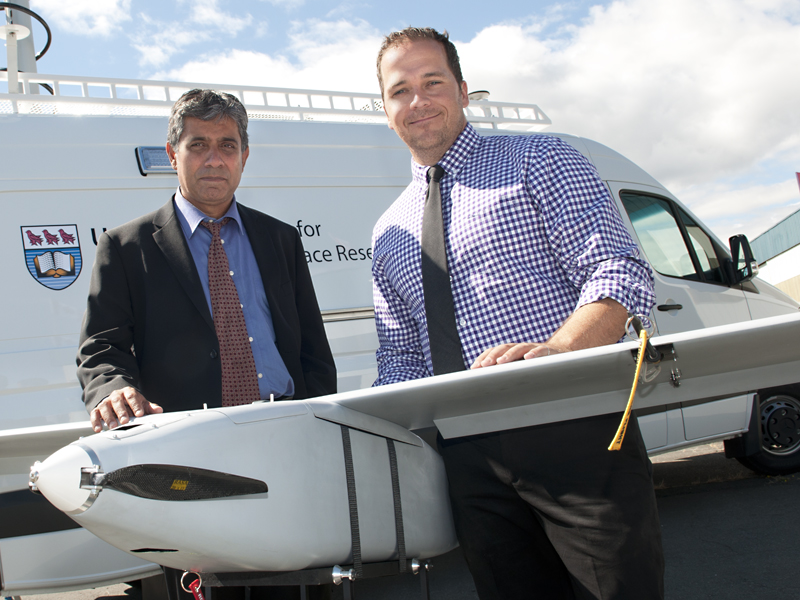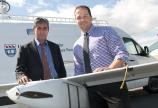UVic-produced unmanned air vehicles to boost BC aerospace industry
- Tara Sharpe

UVic is helping to position Vancouver Island at the leading edge of an emerging aerospace industry here in British Columbia.
Thanks to a $671,500 grant from Western Economic Diversification Canada, UVic’s new Centre for Aerospace Research near Victoria International Airport will be producing an airframe fleet or “family” of UAVs (Unmanned Air Vehicles) from the ground up—including conceptualization, design, manufacture, testing, operation and monitoring.
The UVic UAVs will have a broad range of purposes primarily focused on commercial and industrial applications, including port security, civil disaster response, search and rescue, forest firefighting, coastal patrol, agricultural crop monitoring and aerial mapping. These autonomous aircraft can be remotely flown and monitored from a mobile ground control station located up to 2 kilometres from the flying plane.
The funding was announced at an event on Aug. 24 featuring speakers WD Parliamentary Secretary Andrew Saxton, UVic President David Turpin, Meggitt Training Systems President Spencer Fraser and Viking Air VP of Engineering Martin Swan. The federal funding allows UVic to take a major leap forward in establishing a strong position in a new market—emerging here in BC and around the world—for efficient, competitively priced and highly configurable UAVs.
Civilian UAV commercial use is currently in the embryonic stage in North America, and there is a substantial gap between hobby-grade aircraft used for recreational purposes and prohibitively expensive systems geared specifically for government and military purposes.
UVic’s aerospace design team, originally located in a small office on the UVic campus, has been supported over the past five years by over $1 million in cash and in-kind funding from industry and government partner organizations.
The new centre near Sidney, BC, will be led by aerospace engineer and centre director Prof. Afzal Suleman and, in addition to two colleagues, also includes 10 undergraduate students and five graduate students, including PhD candidate and centre manager Jenner Richards. The student Aero Club on campus will also play a role in development of these airframes.
At present, UVic has produced three full aircraft (UAVs with a wingspan of 3 metres) and several prototypes. Also included is a “quadcopter” with rotating wings, which resembles a helicopter in miniature form.
The UAVs have exciting potential for use in agriculture. “They allow us to check whether, for example, it’s the right time to pick a particular crop,” says Suleman. He uses the example of aerial mapping of a vineyard, which would assess—among other factors—the humidity levels in soil and vines to determine whether the grapes need more water or if it’s a good time to pick the fruit. “Usually this type of work is done manually at a high cost. We can do it in a day or two.”
The UAV would follow a pre-determined route—similar to the type of methodical grid pattern you would trace when mowing the lawn—approximately 500 metres above the ground. A high-definition camera is housed in the belly or undercarriage. The type of UAV used for agricultural crop mapping is the larger model: a fixed-wing aircraft with a 3m wingspan.
The new inventions and industrial patents will be made available for licensing to industry. Suleman expects to have something to offer in that regard within a year.
Suleman points out that the UVic research will look at smaller frames too: from 50cm to 2. m. There are also micro-air vehicles that are the size of an insect, but the centre has not yet worked on this tiny type of UAV.
He also points out another goal is “to increase safety. Hydro workers won’t have to conduct dangerous flights around powerlines, taking pictures from helicopters.” The UAVs can stay up in the air for 30 hours or more, can be back up in the air quickly between operations and have significantly smaller environmental impacts.
The UVic research will be focusing on green technology, such as potentially using electric engines and hydrogen fuel cells.
Video and images of the aircraft—both on the ground and in action: http://bit.ly/UVicUAV (scroll to end of backgrounder)

